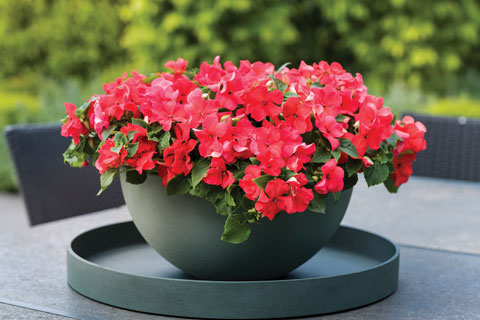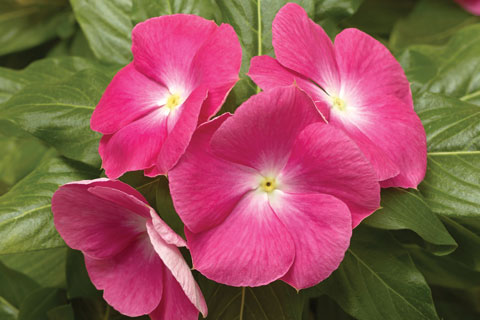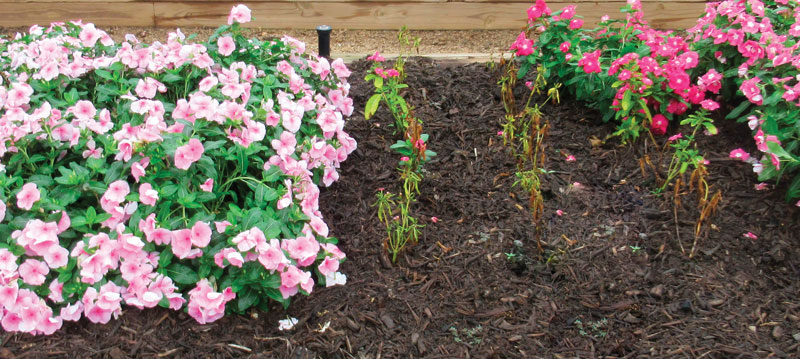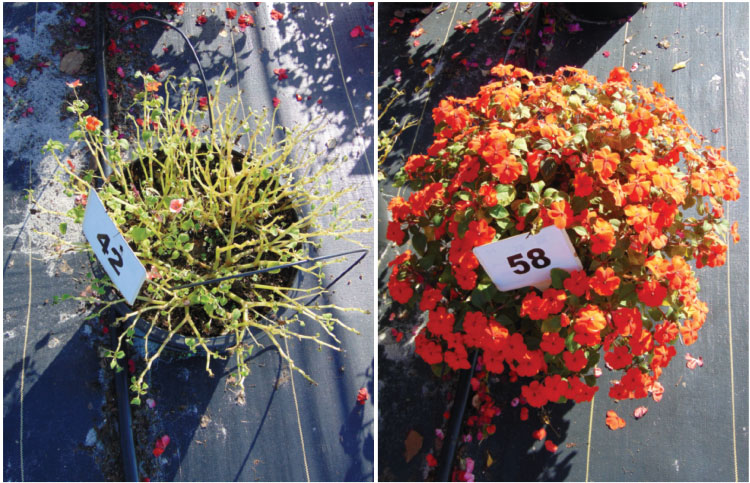2/1/2020
More Tools for the Toolbox
Olivia Sellards, Dr. Jamie Gibson, Dr. Alicain Carlson & Mike Murgiano

Perceptions around disease resistance in the annual flowering plants industry have become a hot topic with the recent introduction of new genetics claiming high levels of resistance. The claim of various levels of resistance to widely spread, naturally occurring pathogens is still being debated as more local and global field performance results come in from growers, professional landscapes and home gardens.
Pictured: Imara XDR Salmon Shades Impatiens.
By applying tried-and-true horticultural logic and a “toolbox” approach to plant diseases, genetic advancements of beautifully thriving flowering annuals can be a profound industry milestone. As with most solutions, Syngenta Flowers suggests a well-rounded, integrated approach in using that toolbox to yield the best and longest-lasting, and perhaps most importantly, responsible results.
A focus on disease resistance
The breeders, pathologists and plant scientists at Syngenta Flowers have been hard at work for decades developing tools to combat diseases that attack flowering plants and landscapes. The fundamental understanding that there’s no “silver-bullet” solution allows for a more holistic approach to controlling the devastating effects of various pathogens. Preventive and curative ornamental chemistries have long been employed in the greenhouse and by landscape professionals to lessen the damage of diseases like aerial Phytophthora and Impatiens Downy Mildew, but until now, it hasn’t been effective to rely on chemistries alone.
Flower breeders are constantly breeding and selecting more resistant varieties in many classes of traditional bedding plants. The recent launch of Syngenta Flowers’ XDR brand takes these claims even further, setting the highest standard in criteria for a new product to have this designation of “Xtreme Disease Resistance.” All XDR products must: 1) Exhibit best-in-class performance under disease pressure; 2) endure rigorous testing in both field and lab settings around the globe; and 3) obtain independent verification from third-party experts in the field. In 2019, Syngenta Flowers launched two brand new flower series that are supported by the XDR claims of resistance: Cora XDR Vinca (F1 Catharanthus roseus) and Imara XDR Impatiens (F1 Impatiens walleriana).
 Pictured: Cora XDR Pink Halo Vinca.
Pictured: Cora XDR Pink Halo Vinca.
Breeding and technologies in vegetables and food crops have supplied a standard terminology set and knowledge base for how disease resistance is defined in agriculture. Ornamental flower growers can gain a better understanding of the term “resistance” by partnering with companies that have a broad understanding of disease resistance breeding in many classes of food crops. Syngenta has long been a foremost breeding expert in this space.
Because these destructive, yet naturally occurring, diseases are constantly evolving in the landscape and natural environments, companies like Syngenta are advocating a responsibility and stewardship approach to the flowers industry regarding new resistant genetics.
“Genetics are one piece of a vast toolbox that has now become available to growers, but it is not the only solution, as the disease will naturally change over time,” said Mike Murgiano, Senior Product Manager at Syngenta Flowers. “Utilizing an approach that includes the newest genetics with resistance, coupled with sound chemical recommendations will give the most sustainable, long-lasting effects, while breeders continue to create varieties that have added levels of self-defense.”
Fighting off Phytophthora
A well-known case study of genetic resistance can be reviewed as we look at the cycle of Cora Vinca breeding over the past three decades. Catharanthus, commonly known as vinca, is a very important crop for many areas of North America, including the hot and humid climates in the southern United States. Vinca succumb to aerial Phytophthora (Phytophthora nicotianae), which can completely devastate municipal and homeowner’s plantings.
After nearly 20 years of working under patents and disease screenings, a breakthrough in breeding allowed Goldsmith Seeds to launch Cora, the first-ever vinca that was resistant to the most virulent strain of aerial Phytophthora in 2007, commonly known as the “S” strain. Soon after launching Cora, however, landscapers began to notice that again, the plants began to succumb to the disease.
 Pictured: Trials of Cora XDR Vinca vs. an existing commercial variety.
Pictured: Trials of Cora XDR Vinca vs. an existing commercial variety.
This development showcases the extremely rapid evolution in the Phytophthora population that began to kill even the most resistant varieties. It was evident that the pathogen was rapidly evolving into more devastating isolates of Phytophthora and that the once-resistant Cora varieties could no longer defend against these more virulent pathogens.
Plant breeders Amanda Hershberger and Shifeng Pan are working continually at Syngenta Flowers to stay ahead of this fast-changing pathogen to create improved varieties that have the strength, vigor and resistance for the next generation of Cora Vinca, holding the XDR brand promise.
“I have seen rapid evolution in my own inventory of isolates. We are breeding these traits continually, but resistance fades as the isolates become more devastating,” said Amanda.
Breeding in this class of premium, disease-resistant, F1 vinca for Syngenta Flowers is a major priority and requires many trials and replications, and industry partnerships to stay on top of the newest threats. In collaboration with Clemson University and trialing locations around the U.S., the newest breeding lines and hybrids are put through extremely rigorous, blind testing, being inoculated with isolates of Phytophthora at higher rates than would occur in natural settings.
“There is no escape! We are very hard on these plants. We must accept total annihilation in susceptible materials to ensure the highest levels of resistance in our genetics. This type of breeding is not for the faint of heart,” said Amanda.
 Pictured: A susceptible Impatiens walleriana at eight weeks on the left and Imara XDR Orange at eight weeks on the right.
Pictured: A susceptible Impatiens walleriana at eight weeks on the left and Imara XDR Orange at eight weeks on the right.
Flower breeders must constantly work on new varieties to keep up with the evolution of diseases that occur naturally. Coupling resistant genetics with other modes of action to control disease is Syngenta’s “responsible mindset” message, reminding growers and landscapers that we must rely on more than one tool when managing diseases. The technical plant scientists and pathologists at Syngenta Flowers have been supporting the bedding plant and landscaping industry’s battle with these problems for decades, providing chemical rotation schedules, common-sense culture tips and grower-specific recommendations to lessen exposure and provide preventive and curative control to these diseases.
With a deep understanding of the pathogens and how they behave in nature, the collective level of support and treatment for these problems has shifted and led many to better control. Integrated controls are widely accepted as the most responsible way to combat disease and pest challenges, even when breeders are confident in their genetics.
Combating IDM from all sides
Plant patents, replicated trials, third-party collaboration and breeding cycles have all proven to be factors that are needed in modern disease-resistant breeding and shouldn’t be overlooked. It takes much coordination and work to create disease-resistant plants, and to rely on genetics alone is a risky approach for an industry that’s based on plant science and data.
The case study of Impatiens Downy Mildew (commonly known as IDM, caused by the fungal pathogen Plasmopara obducens) is the newest debated disease that now has resistant genetics available to the horticulture industry. Syngenta’s stance on coupling the new IDM-resistant Imara XDR impatiens with a solid preventive fungicide program has been challenged by a resistant “genetics-only” argument. During the years of hard work by pathologists and breeders alike, Syngenta Flowers suggests that data should drive all scientific claims to resistance.
As set by the criteria for XDR-level genetic claims and external collaboration, Cornell University has officially marked Imara XDR Impatiens with a high degree of resistance to IDM.
“Pathogens evolve and mutate rapidly in the natural environment and a long-term, integrated management approach is the best way to make these genetics last for consumers and profitable for growers,” said Dr. Jamie Gibson, Syngenta Flowers Technical Lead, who’s coached growers for years on preventing, treating and overcoming severe challenges in regard to diseases. Syngenta’s technical team of scientists from both the genetics and chemistry divisions agree that disease-resistant genetics are a great step forward in healthy landscapes, but can become less effective over time as environments change.
Fungicide rotations for IDM also help protect Impatiens walleriana from other serious fungal pathogens that they’re susceptible to, including Pythium, Phytophthora, Rhizoctonia, Thielaviopsis, Myrothecium, Alternaria and Botrytis. For these reasons, base level preventive fungicide applications are recommended at all stages of production for general sanitary and stewardship reasons.
At public flower trials over the summer of 2019, IDM-resistant impatiens varieties were observed succumbing to attacks by other, non-IDM pathogens. Had these plants been treated with common fungicides and prevention methods, the plantings would have likely survived. Although all breeding and selection work for Imara XDR was done without preventive chemistries, and Syngenta Flowers stands strongly behind their message of resistance, the collective expertise suggests continuing to safeguard this important class and take a more steady and responsible approach to managing this widespread problem. Syngenta Flowers has a vast online library of information available for these treatment options and many technical experts that can provide suggestions and rotation schedules.
Because the Imara XDR series provides genetic resistance in a full range of colors, it lessens the need to produce other non-resistant varieties, which would increase the risk of exposure to IDM at all stages. Even with the expanded range of colors and mixes, Syngenta Flowers continues to suggest a safeguard approach by using preventive fungicides, especially in propagation and prior to shipping.
The Syngenta Flowers team is proud of these achievements in advanced disease resistant breeding and has gained attention on stages around the globe. Imara XDR Impatiens first launched in the European market and sold out immediately at retail outlets around the United Kingdom. Consumers were exclaiming, “Busy Lizzies are back” and were delighted to have a garden favorite back on the retail shelves. Recently, too, Imara Impatiens won the TASPO Award of the Year for Best Breeding Product. This is the second award for Imara after it was awarded for Best Ornamental Plant Introduction—Bedding by Horticulture Week Business Award in London in June 2019.
Innovative, disease-resistant flowers like Cora XDR Vinca and Imara XDR Impatiens are true breeding breakthroughs. They have not only helped growers and consumers, but they’ve also inspired other breeders to turn their sights to developing genetic disease protection in more and more bedding crops. This is evident in many important classes in the current horticulture realm and in breeding pipelines globally.
But as the collective understanding of the roles taken by breeders, growers, retailers and landscapers is better defined, it’s easy to see that there’s no one-tool approach to complex disease problems. Growers, however, should take comfort to know that breeding objectives are in place to maintain high resistance and continue to bring plant potential to life.
Important Resistance Terminology
• Immunity: When a plant isn’t subject to attack or infection by a specified pest.
• High Resistance: Plant varieties that highly restrict the growth and/or development of the specified pest and/or the damage it causes under normal pest pressure when compared to susceptible varieties. These plant varieties may, however, exhibit some symptoms or damage under heavy pest pressure. Varieties claiming the same level of resistance against a specific pest may exhibit a different resistance response due to a different genetic makeup of a variety.
• Intermediate Resistance: Plant varieties that restrict the growth and/or development of the specified pest and/or the damage it causes but may exhibit a greater range of symptoms or damage compared to high resistant varieties.
International Seeds Federation: Definition of the Terms Describing the Reaction of Plants to Pests for the Vegetable Seed Industry (Adopted by the ISF Vegetable and Ornamental Crops Section in May 2017) GT
Olivia Sellards is Customer Marketing Manager, Dr. Jamie Gibson is Technical Lead, Dr. Alicain Carlson is Technical Trial Manager, and Mike Murgiano is Senior Product Manager for Syngenta Flowers.